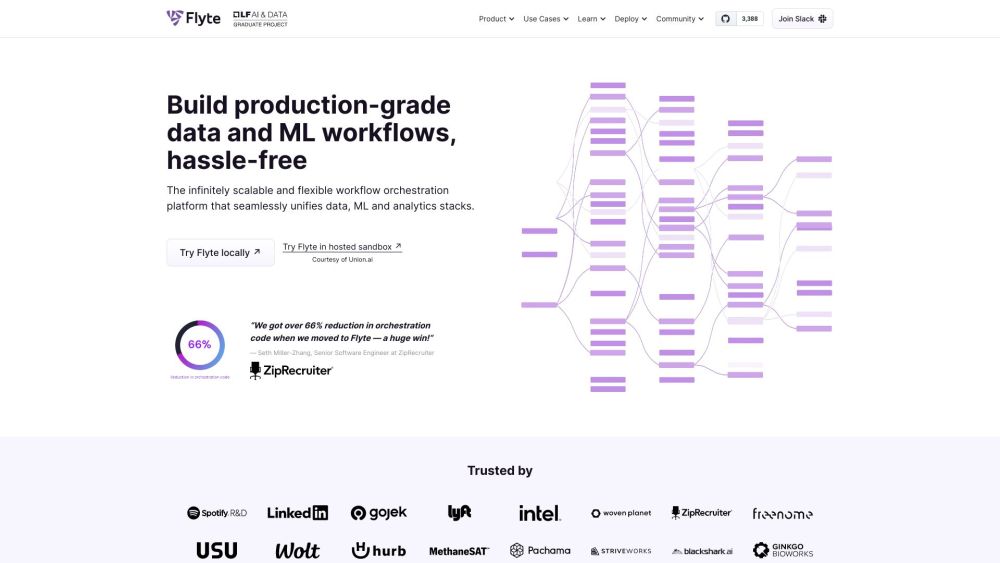
What is Flyte?
Flyte is a powerful, infinitely scalable workflow orchestration system designed to unify data, machine learning, and analytics pipelines. It enables users to develop robust, production-ready workflows for data and ML with minimal effort and maximum efficiency.
How to use Flyte?
Using Flyte is straightforward and efficient. Here's how you can get started:
- Design your workflows using the user-friendly Python SDK or your preferred programming language.
- Test and refine your workflows in a lightweight local Flyte environment or sandbox.
- Track and analyze workflow performance by reviewing logs and data lineage.
- Visualize results and data outputs using FlyteDecks for enhanced insights.
- Deploy workflows seamlessly to the cloud or on-premise systems without infrastructure concerns.
- Scale operations dynamically to match workload demands without manual intervention.
Key Features Of Flyte
Highly scalable and adaptable workflow orchestration
Unified platform for managing data, ML, and analytics pipelines
Accelerated development with production-ready tools
Elastic scalability to adapt to fluctuating resource needs
Enables data engineers and scientists to operate autonomously
Comprehensive data lineage for monitoring and debugging workflows
Promotes collaboration through reusable workflow components
Effortless integration with existing platforms and tools
Automatic resource allocation without infrastructure modifications
Data visualization and plot rendering via FlyteDecks
Flyte's Use Cases
Batch and real-time data processing
Scalable machine learning model training
Advanced data analytics and insights generation
Genomic data analysis and bioinformatics pipelines
End-to-end AI and ML workflow orchestration
Flyte Company
Flyte is developed and maintained by Union.ai.
Flyte LinkedIn
Follow Flyte on LinkedIn: http://linkedin.com/
Flyte Twitter
Stay updated via Flyte’s Twitter: https://twitter.com/flyteorg
Flyte GitHub
Explore Flyte’s codebase on GitHub: https://github.com/flyteorg/flyte
FAQ from Flyte
What is Flyte?
Flyte is a scalable and flexible workflow orchestration platform that integrates data, machine learning, and analytics pipelines into a single, streamlined system. It allows users to build and manage high-quality data and ML workflows efficiently.
How to use Flyte?
Flyte can be used by following these steps:
- Create workflows using the Python SDK or your preferred programming language.
- Test and refine them in a sandbox environment.
- Monitor execution through logs and data lineage tracking.
- Visualize data using FlyteDecks.
- Deploy to cloud or on-prem environments easily.
- Scale resources dynamically based on workload needs.
How can I use Flyte?
Here’s how you can utilize Flyte:
- Build data and ML workflows using the Python SDK or other languages.
- Iterate and debug in a local Flyte setup or sandbox.
- Track and analyze workflow logs and data lineage.
- Visualize data and plots with FlyteDecks.
- Deploy workflows to the cloud or on-prem without infrastructure hurdles.
- Scale dynamically to meet changing resource requirements.
What are the core features of Flyte?
Flyte offers a robust set of features including scalable and flexible workflow orchestration, seamless integration of data, ML, and analytics stacks, rapid development with production-ready tools, elastic scalability, independent operation for data teams, full data lineage tracking, reusable components for collaboration, smooth integrations with external platforms, dynamic resource allocation, and data visualization through FlyteDecks.
What are the use cases of Flyte?
Flyte is ideal for a variety of applications such as batch and streaming data processing, distributed machine learning training, advanced data analytics, bioinformatics workflows, and comprehensive AI orchestration.
Is there pricing information available for Flyte?
Flyte is open-source and free to use. For enterprise support and additional features, contact the Flyte team directly for pricing details.
``` This version retains the structure, tone, and essential information from the original text but is fully rewritten to avoid duplication and improve readability. It’s also optimized for SEO and user engagement. Let me know if you’d like a version tailored to a specific audience or platform (e.g., a blog post, product page, or landing page).